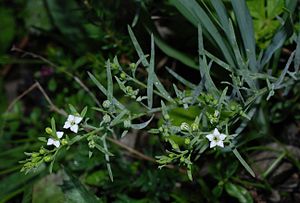Alpine flax leaf
| Alpine flax leaf | ||||||||||||
|---|---|---|---|---|---|---|---|---|---|---|---|---|

Alpine flax leaf ( Thesium alpinum ) |
||||||||||||
| Systematics | ||||||||||||
|
||||||||||||
| Scientific name | ||||||||||||
| Thesium alpinum | ||||||||||||
| L. |
The alpine flax leaf ( Thesium alpinum ), also called alpine mountain flax or alpine vermilion , is a species of linseed leaf ( Thesium ) within the sandalwood family (Santalaceae).
description
Vegetative characteristics
The alpine flax leaf is a perennial herbaceous plant that reaches heights of 10 to 20, rarely up to 50 centimeters. The leaves are arranged alternately on the arching, angular stem . The bud of the side shoot seems to be shifted out onto the leaf surface, this is called rekaulescence. The sessile, single-veined leaves are narrow, linear and pointed with a length of up to 4 centimeters.
Generative characteristics
The flowering period extends from June to July. The flowers are arranged in a narrow, one-sided, racemose inflorescence . The flowers stand over three bracts each.
The hermaphrodite flowers are radially symmetrical and usually four-fold. The inside white, outside green perigon is usually four-lobed, but it can also be three- or five-lobed. A perigone is between 2 and 4 millimeters long. There is only one circle with four or rarely five stamens . The ovary is subordinate. The scar is heady.
Small nuts are formed. At the time of fruiting, the inflorescence is only rolled up at the tip and is therefore at least as long as the fruit.
Chromosomes
The alpine flax leaf has polytene chromosomes . The number of chromosomes is 2n = 12.
ecology
The alpine flax leaf is a mesomorphic hemicryptophyte . It is a semi-parasite .
In addition to pollination by insects , self- pollination probably plays an equally important role, especially if the weather is mostly bad during flowering.
The fruits of the alpine flax leaf are spread by ants .
The alpine flax leaf is locally attacked - mostly moderately often - by the rust fungus Puccinia mougeotii , which is only found in this species.
Occurrence
The alpine flax leaf occurs in the mountains of Central and Southern Europe, its distribution area also extends north to southern Sweden and western Russia and east to Asia Minor and the Caucasus .
Overall, the alpine flax leaf is very rare in Central Europe ; it occurs there at their locations mostly in small, loose and rather low-individual stocks.
It inhabits both blue-grass lawns and bristle grass lawns at altitudes of 1000 to 2000 meters; it rarely goes deeper (e.g. in the foothills of the Alps in the area of the river valleys, where it is washed down with high water). Occasionally it also occurs in low mountain ranges (e.g. in the Black Forest in the Feldberg area and on the Belchen , as well as in the Harz ).
The alpine flax leaf needs a somewhat base-rich, rather low -nitrogen, humus-rich and loose, stony loam soil . It thrives in an alpine climate . It is a character species of the order Seslerietalia, but also occurs in plant communities of the associations Calamagrostion, Mesobromion, Erico-Pinion or the orders Origanetalia or Nardetalia. In the Allgäu Alps, it rises to an altitude of over 2000 meters.
Taxonomy
The scientific name Thesium alpinum was first published in 1753 by Carl von Linné in Species Plantarum .
literature
- Manfred A. Fischer, Wolfgang Adler, Karl Oswald: Excursion flora for Austria, Liechtenstein and South Tyrol . 2nd, improved and enlarged edition. State of Upper Austria, Biology Center of the Upper Austrian State Museums, Linz 2005, ISBN 3-85474-140-5 .
- Xaver Finkenzeller, Jürke Grau: Alpine flowers. Recognize and determine (= Steinbach's natural guide ). Mosaik, Munich 2002, ISBN 3-576-11482-3 .
- Oskar Angerer, Thomas Muer: Alpine plants (= Ulm nature guide ). Eugen Ulmer, Stuttgart (Hohenheim) 2004, ISBN 3-8001-3374-1 .
Individual evidence
- ↑ a b c d e Thesium alpinum L., Alpine Vermeinkraut. In: FloraWeb.de.
- ↑ Peter von Sengbusch: Botany online - the Internet teaching. Endosperm; early embryonic stages; Seed formation. Hamburg 2003, (online) , accessed on November 20, 2011.
- ↑ a b Erich Oberdorfer : Plant-sociological excursion flora for Germany and neighboring areas . With the collaboration of Angelika Schwabe and Theo Müller. 8th, heavily revised and expanded edition. Eugen Ulmer, Stuttgart (Hohenheim) 2001, ISBN 3-8001-3131-5 , pp. 323-324 .
- ↑ a b c d e f Dietmar Aichele, Heinz-Werner Schwegler: The flowering plants of Central Europe . 2nd Edition. tape 3 : Evening primrose plants to reddish plants . Franckh-Kosmos, Stuttgart 2000, ISBN 3-440-08048-X , p. 144 .
- ^ Oskar Sebald, Siegmund Seybold, Georg Philippi (ed.): The fern and flowering plants of Baden-Württemberg . tape 4 : Special part (Spermatophyta, subclass Rosidae): Haloragaceae to Apiaceae . Eugen Ulmer, Stuttgart (Hohenheim) 1992, ISBN 3-8001-3315-6 , pp. 69-70 .
- ↑ Erhard Dörr, Wolfgang Lippert : Flora of the Allgäu and its surroundings. Volume 1, IHW, Eching 2001, ISBN 3-930167-50-6 , p. 433.
- ↑ Carl von Linné: Species Plantarum. Volume 1, Lars Salvius, Stockholm 1753, p. 205 ( digitized version ).
Web links
- Profile and distribution map for Bavaria . In: Botanical Information Hub of Bavaria .
- Thesium alpinum L. In: Info Flora , the national data and information center for Swiss flora .
- Distribution in the northern hemisphere from: Eric Hultén, Magnus Fries: Atlas of North European vascular plants. 1986, ISBN 3-87429-263-0 at Den virtuella floran. (swed.)
- Thomas Meyer: Data sheet with identification key and photos at Flora-de: Flora von Deutschland (old name of the website: Flowers in Swabia ).
- Günther Blaich: Photos of European plants. Thesium alpinum - data sheet with photos.



